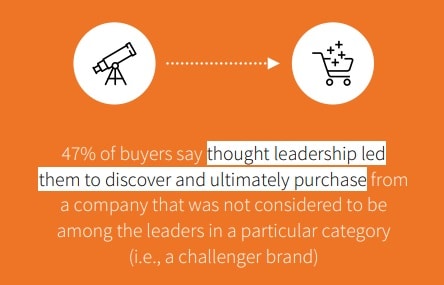How to Conduct and Publish Industry Research
If you’re a marketer, you know the value of high-quality, original industry research. Brands that provide compelling statistics, visuals, and reports about important industry topics earn more backlinks and higher visibility than their competitors. Today, thanks to technology and data accessibility, every company can conduct industry research.
In this article, we’re going to cover exactly how to do it. In the sections that follow, we will:
- Define industry research as it exists in the marketing world
- Walk through 6 important benefits of publishing original industry research
- Go step-by-step through the process of conducting industry research
Let’s get started.
Quick Takeaways
- Original industry research establishes brands as thought leaders.
- Other benefits of conducting industry research include backlinks and higher levels of customer trust.
- Industry research should always have clear goals and a dedicated team.
- About half of all companies that conduct industry research partner with a third-party organization to do it.
What is industry research?
Industry research is any original research performed by an organization about relevant topics within that industry. In the content marketing world, industry research is used to create thought leadership content, establish brand authority, and report on trends that impact organizations and customers.
There are a few different methods for performing compelling industry research. The first is by conducting surveys. Researchers release surveys to target groups of participants, collect original data, and share the results. The second is by analyzing existing data to draw new conclusions.
A good example of survey-based research are annual benchmark reports. Companies survey large participant groups, then use the results to build reports like “The Current State of X Topic” or “X Topic in 2022.” These reports discuss current industry norms and emerging trends for the future — all based on responses from actual companies or customers in that industry
Industry research based on existing data positions itself as the most comprehensive resource for a topic that’s already covered frequently within an industry. It curates all existing data on the topic and draws definitive conclusions about it. It also identifies new insights that may not have been uncovered before and explores opportunities for future research.
In any case, quality industry research establishes a brand’s position as experts in their field. It makes them a place other brands turn to for information that drives their own content creation.
Two examples that come to mind in the content marketing world are the Content Marketing Institute and HubSpot. Both product industry research so frequently that it’s rare to Google any single digital marketing-related topic without seeing them on the results page.
In the next two sections, we’ll dive into specific benefits of producing industry research, plus how to conduct and publish it as part of your brand’s content marketing strategy.
Benefits of Publishing Industry Research
Establishes Thought Leadership
Thought leadership content is any content that builds your brand’s credibility as an expert. In the B2B world especially, thought leadership is important because it tells customers they can be confident in your ability to deliver solutions — both in the form of products and services as well as industry knowledge and expertise.
B2B buyer decisions have significant and long-lasting impacts on their organizations, so this level of confidence is something they seek out during the buyer journey. Research by Edelman and LinkedIn reports that the majority of B2B decision makers (64%) think a company’s thought leadership content is “a more trustworthy basis for assessing its capabilities and competency” than its marketing and promotional content.
To boot, they think that thought leadership content can bump brands ahead of competitors who may have more name recognition. In fact, 47% of respondents in this study said thought leadership content led them to find and ultimately choose a company that wasn’t considered a leader in that particular category.
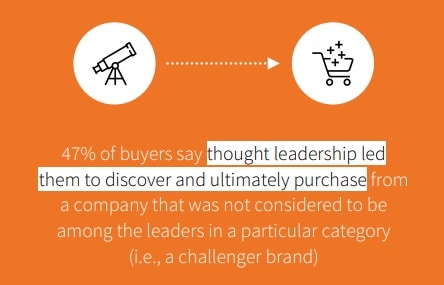
Image Source: Edelman
So there you have it: original research not only builds your reputation, it can be the very thing that makes a buyer decide to choose you over competitors — even when those competitors have more name recognition or a more established market share.
Boosts Your Link Building Strategy
Link building — the process of earning backlinks from other websites to drive traffic to your site — takes time and several approaches. Industry research is one of them. When your research is cited by other brands, it’s also likely that readers will make their way to the original source (your site) to read more on the topic.
Consider the original industry research I cited above from Edelman-LinkedIn. That’s kind of research is what I needed to make this article more compelling and complete. I used their data to drive home the points I know are important for you to know about thought leadership.
I’m certainly not the only one who’s cited it. Plus, there will be a number of readers from this article who will go read more from their report.
In short: original industry research helps boost your link building strategy because it makes other brands’ content better. Over time, this drives more organic traffic and potential customers to your own website.
Builds Customer Trust
Trust is one of the most important factors in a B2B buying decision. Not only do buyers consider trust to be necessary for them to choose a particular brand, it also leads to a number of other benefits that can drive business for your company — higher likelihood of earning referrals, more frequent purchases, higher engagement, and a willingness to pay higher prices.
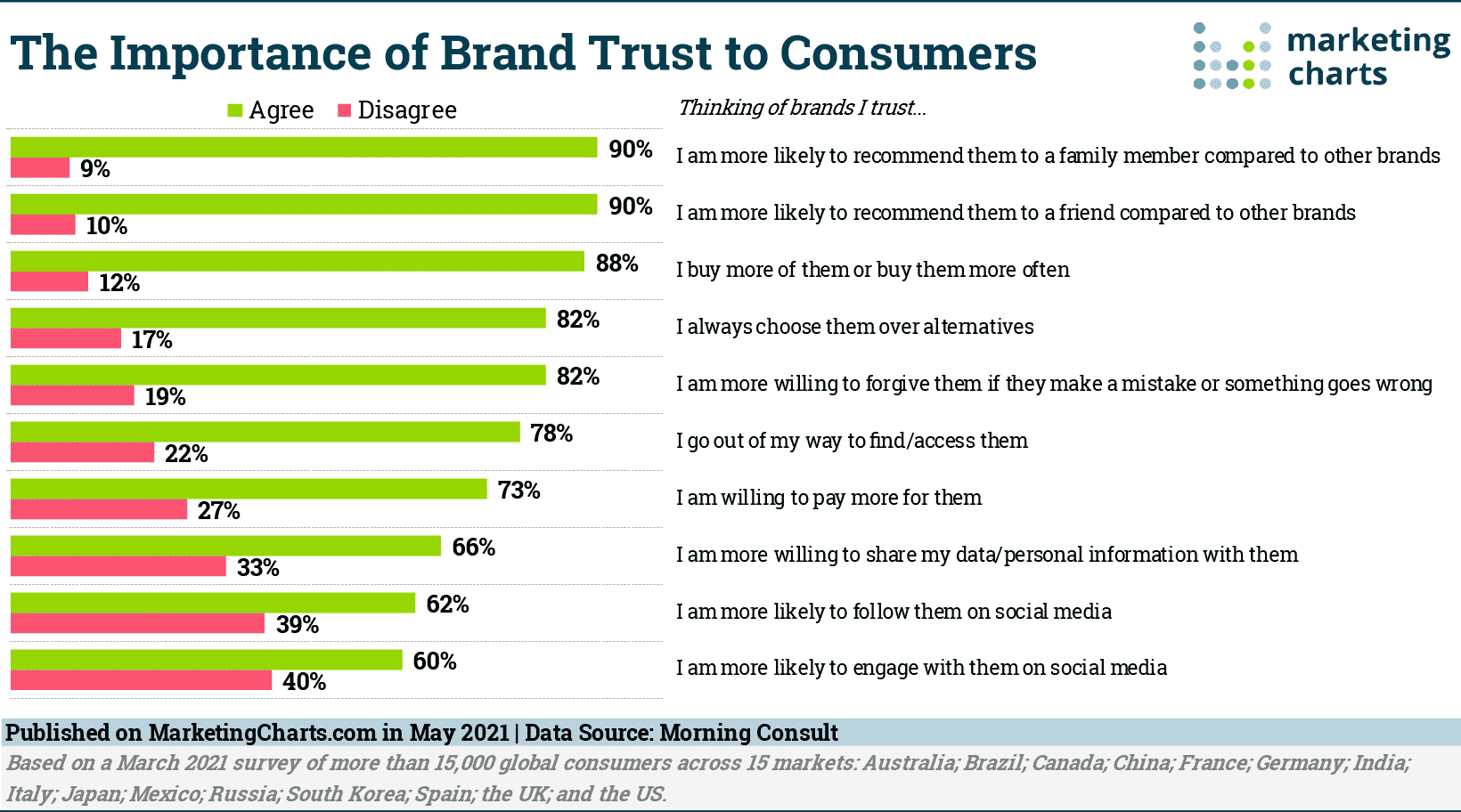
Image Source: Marketing Charts
Industry research builds this important trust factor with your audiences because it shows your company is a leader — one that knows which topics are most important and provides valuable insights on it for others in the industry.
Creates Opportunities for More Content
Original industry research can create tons of opportunities to create more high-value content for your audiences. This might come in the form of different content types — an infographic, for example, that highlights important statistics from the research. You may also cover topics within the topic in more detail in other content pieces — for example, a blog post that analyzes one specific and interesting finding from a larger report.
Finally, industry research usually yields opportunities for further research (and thus more content) because it identifies topic areas that need more exploration and research behind them.
Studies have shown that the most successful marketers create nearly 3x the amount of content from original research than their less successful competitors.
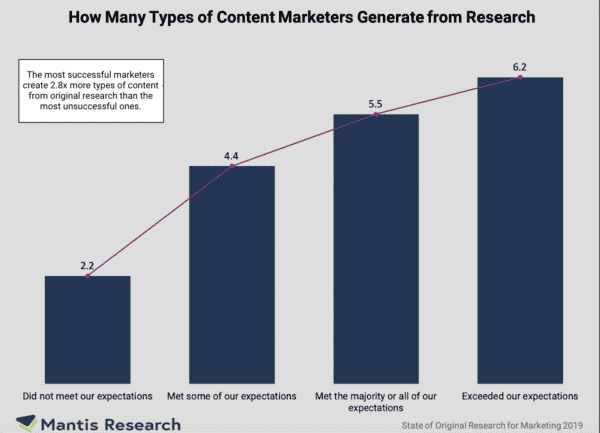
Image Source: Mantis Research
Gives You Insight
Your audiences aren’t the only users getting important insights from your industry research. When you perform research, you gain critical insight into your industry — that could be through feedback shared by survey participants, understanding trends through third party analysis, and more. You can use these insights to refine strategies and drive better results for your business.
Drives Traffic
Ultimately, all of these other benefits yield one important result for your company: more organic traffic to your website. And when you drive more organic traffic to your site on a regular basis, you can expect bigger results to follow: more leads, higher conversions, and increased sales.
How to Conduct and Publish Industry Research
Identify a Need
Conducting industry research begins with identifying a need — an information gap that your original research could fill. Think about the following to find these information gaps:
- Topics you want/need to know more about, but can’t find quality information on
- Topics covered heavily in your industry that still lack definitive or trustworthy insights
- Questions posed by your customer groups that warrant further exploration
- Emerging trends in your industry that don’t yet have industry research behind them
- Opportunities from your owned data that could yield valuable insights
- Topics most important to your brand that could be covered in benchmark reports
Set Goals for Your Industry Research
Setting goals for your industry research drives its overall direction throughout the process and helps you achieve its intended ROI. To identify your industry research goal, think back to the original need you identified and the purpose for conducting your industry research in the first place.
For example: are you looking to educate your customers on an important product-related topic? Understand buyer behavior? Build authority with better research on an already well-covered topic? Be the first to cover an emerging trend in your industry?
Knowing what you’re trying to accomplish helps you set the right action steps to execute your industry research.
Build Your Team
Next, decide who will execute your research. In the case of industry research for content marketing, your own marketing team will likely lead the charge. Identify who within that marketing team will play a role in executing the research.
Also include others from your organization who have the right expertise or information access to contribute to your research. For example, you may include data analysts who can help you access owned data.
You may also work with a third party organization whose members are part of your team (more on that later).
Establish Your Methods
Next it’s time to determine the methods you’ll use to conduct your industry research. Again, this may depend on the topic. You can also employ a combination of research methods to get comprehensive results.
For example, if your topic is related to buyer behavior, you may send a survey to collect data while also analyzing owned historical data about your customers.
Create a Plan
Developing a documented plan enables you to set deadlines, assign responsibility, and keep your team accountable throughout the research process. It also prevents important action steps from falling through the cracks.
Your plan doesn’t need to be anything fancy. A Google sheet with tasks and deadlines is enough — but it should be shared and frequently updated to keep your research process on track.
Execute Your Plan
Once you’ve got the right building blocks in place, it’s time to execute your plan. Create a schedule for your research team to meet and check in periodically. Refer to your documented plan to keep things running smoothly and on deadline.
Analyze Results
Once you’ve executed your research plan, it’s time to analyze your results. Refer back to your original research goals to drive the process for data analysis. As a research team, go over the data you’ve collected and determine the most relevant and important ways to analyze it.
For example — you may report on survey questions by straightforward response, but then also break responses down by user group or demographics to get deeper insights. This step is best performed with support from data analysis tools that can help automate the process and ensure accuracy.
Distribute and Amplify
It’s important to be strategic about how you distribute your original industry research. Industry research is more valuable than standard blog or email content. Leverage it as such to drive traffic and grow your audience.
You may want to use your research report as a gated lead magnet, which requires users to share their information in order to access the content. You can write blog articles and social media posts that include parts of your research and pique interest, then drive people to your website to access it in full.
The lead magnet approach keeps your content accessible while boosting the ROI you earn from it in the form of new leads. At the same time, your research gets amplified by the other content you create related to it on your blog, social platforms, and email.
Do you need to partner with another company to conduct industry research?
The short answer: no, it’s not a requirement. But there are some real benefits to doing so. Third-party research firms provide expertise on the process, and they’re an objective guide throughout.
A recent survey found that about half (49% to be exact) of companies performing original industry research partner with third-party firms to expand their audience and increase the number of survey participants.
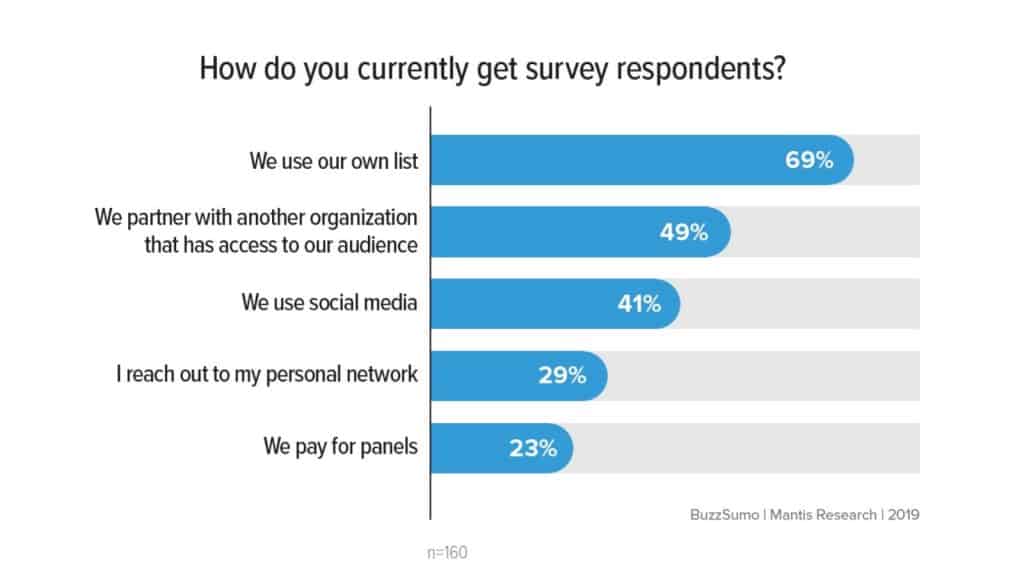
Image Source: BuzzSumo | Mantis Research
In short: you can absolutely conduct industry research on your own, but a third-party partner — if it fits in your budget — can level up the quality and size of your participant pool, plus provide valuable expertise and support on process execution.
Build Your Brand Reputation with Great Content
Conducting industry research is one effective way to build your reputation with content. You can expand on this strategy with frequent, customer-focused blog articles that cover the topics most important to your brand.
But creating and publishing content at volume is time consuming. The team of writers and SEO experts at Marketing Insider Group can deliver you optimized, ready-to-publish content every week for a year (or more) so that you can focus on your core business priorities.
Check out our SEO Blog Writing Service or schedule a quick consultation to learn more.
The post How to Conduct and Publish Industry Research appeared first on Marketing Insider Group.

